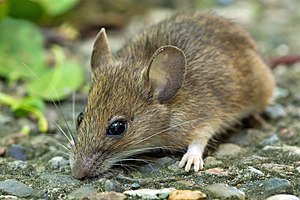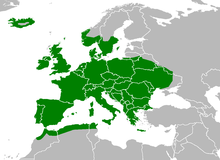Wood mouse
| Wood mouse | ||||||||||||
|---|---|---|---|---|---|---|---|---|---|---|---|---|

Wood mouse ( Apodemus sylvaticus ) |
||||||||||||
| Systematics | ||||||||||||
|
||||||||||||
| Scientific name | ||||||||||||
| Apodemus sylvaticus | ||||||||||||
| ( Linnaeus , 1758) |
The wood mouse ( Apodemus sylvaticus ) is a species of mammal from the family of long-tailed mice (Muridae). This relatively small and large-eyed long-tailed mouse inhabits large parts of the western Palearctic and, contrary to its name, inhabits mainly open habitats, including agricultural areas, fallow land, waterfronts and parks. The wood mouse is one of the most common mammalian species in Europe and, according to the IUCN, is not endangered.

features
The wood mouse is one of the smaller species of the genus Apodemus . The ears are relatively large, the eyes very large and clearly protruding. The head-trunk length is 80–110 mm, the tail length 70–115 mm, the length of the hind feet 20.0–23.5 mm and the ear length 15–20 mm. The animals weigh 13–36 g, mostly 18–25 g. The fur is yellow to brown-gray on top, with a hint of red-brown in older animals. The underside is dirty white, the demarcation from the coloring on the upper side is not very clear. There is no breast drawing or it is only a yellowish-brown, longitudinally oval spot. The hind feet are hairy white on top.
distribution and habitat
The distribution area of the wood mouse covers large parts of the western Palearctic . In a west-east direction, the area extends from Iceland , Ireland and Portugal to eastern Ukraine and the extreme southwest of Russia as well as the extreme west of Turkey . In north-south direction, the distribution extends from the south of Norway and Sweden to the north of Morocco , Algeria and Tunisia , to Sicily and to the south of Greece including Crete .
The altitude distribution ranges from sea level to about 2000 m in the Alps ; in the Atlas Mountains up to 3300 m.
Contrary to its name, the wood mouse inhabits mostly fringing biotopes of the agricultural landscape, especially hedges, fallow land, ditch edges and river banks, but also parks and gardens. In the north-east of the area, the species is largely restricted to these areas and only inhabits very open, dry coniferous forests here. In the west and south of the distribution area, wood mice also occur in closed high forests. The main reason for the lack of forests in most of the area is apparently their extensive settlement by the larger and more competitive yellow-necked mouse .
Wood mice often come into buildings and also use facade vegetation to get under the roof.
Way of life
Wood mice are mostly nocturnal and climb well. The deep earthworks have two entrances and a nest and a pantry. The nests are inhabited by several animals in winter. The wood mouse is omnivorous . The diet consists mainly of seeds and fruits such as acorns , beechnuts and hazelnuts , buds, fruits, mushrooms, tubers and insects.
The reproduction takes place in the north of the area from March to October, in the Mediterranean area all year round. In Central Europe there are usually three litters a year. The gestation period is 23-24 days. The litters include 2–8, mostly 5–6 young. The newly born young mice weigh 1.5–2.0 g; their eyes open at 12-14 days of age. Females are sexually mature in the summer of the year of birth.
The wood mouse shows clear, but not cyclical population fluctuations depending on the food supply. In forests, the settlement density can rise to over 50 individuals / hectare in fattening years, and in years with little food it can be below one individual / hectare.
Wood mice were the first mammal species to be detected as having a magnetic sense in 1981 .
Existence and endangerment
The wood mouse is one of the most common mammalian species in Europe; the population is apparently stable overall. The species is classified as harmless worldwide by the IUCN ( least concern ).
Web links
- Apodemus sylvaticus in the endangered Red List species the IUCN 2009. Posted by: Schlitter, D., van der Straeten, E., Amori, G., Hutterer, R., Krystufek, B., Yigit, N. & Mitsain, G ., 2008. Retrieved January 17, 2010.
swell
literature
- Stéphane Aulagnier, Patrick Haffner, Anthony J. Mitchell-Jones, François Moutou, Jan Zima: The mammals of Europe, North Africa and the Middle East. The destination guide. Haupt, Bern u. a. 2009, ISBN 978-3-258-07506-8 , pp. 232-233.
- Anthony J. Mitchell-Jones, Giovanni Amori, Wieslaw Bogdanowicz, Boris Krystufek, PJH Reijnders, Friederike Spitzenberger, Michael Stubbe, Johan BM Thissen, Vladimiŕ Vohralik, Jan Zima: The Atlas of European Mammals. Poyser, London, 1999, ISBN 0-85661-130-1 , pp. 274-275.
- Erwin Stresemann (founder), Konrad Senglaub (ed.): Excursion fauna of Germany. Volume 3: Vertebrates. 12th, heavily edited edition. G. Fischer, Jena a. a. 1995, ISBN 3-334-60951-0 , pp. 412-413.
Individual evidence
- ↑ The wood mouse on the IUCN Red List, with distribution map
- ^ Dietrich Dolch: Contributions to the mammal fauna of the state of Brandenburg. The mammals of the former Potsdam district (= nature protection and landscape conservation in Brandenburg. Special issue, 1995, ISSN 0942-9328 ). State Environmental Museum Brandenburg, Potsdam 1995, pp. 33–34.
- ^ Janice G. Mather and R. Robin Baker: Magnetic sense of direction in woodmice for route-based navigation. In: Nature . Volume 291, 1981, pp. 52-155, doi: 10.1038 / 291152a0 .





